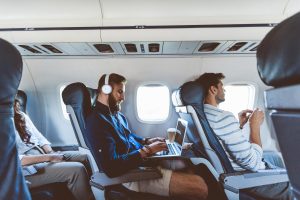Learning how to grow herbs is a great practice in sustainability, as it means less reliance on store-bought products which, in turn, reduces waste. It also means you’ll have an array of fresh-smelling herbs in your home to snip from and enhance your meals whenever you need!
You can start your herb garden any time of year – especially if you have a room or window that gets good sunlight – but it’s best to begin in the spring when more herbs are in season and readily available for purchase. The kind of herbs you select are up to you and your tastes, but basil and green onion are some of the easiest to propagate and a great place to start.
Step One: Buy A Plant From The Store
Growing herbs from seeds is totally doable, but purchasing an already budding plant from the grocery store will save you lots of time.
In some supermarkets, you can find starter basil plants in the produce or flower sections. These may look healthy at the time of purchase, but often there are numerous plants crowded into one pot, which creates a competition for nutrients and eventually leads to an unhappy plant that doesn’t produce much (if any) new growth. If you choose to buy a plant, we recommend taking it out of its pot, separating the plants and propagating from there.
Buying a package of fresh basil will work, too. Look for a container with long stems and leaves that are not yet yellowing. This is a good indicator that it will propagate, or start new growth, well.
Green onions (scallions) are even simpler because they come with their roots still attached; just grab a healthy-looking bunch from the produce section.
Step Two: Snip and Start Rooting
It’s important to know exactly where to cut to ensure your cuttings will take root and grow into their own new plant.
With basil (and rosemary, mint and sage, to name a few), look for part of the stem where two smaller shoots have grown on either side. Snip the stem just above the side shoots. Make sure to use clean garden pruners for this part. Then, drop your cuttings (snipped end down) into a small container with water.
Here’s a helpful visual from gardening expert @joesgarden.official.
If your basil isn’t taking root in water, try either using a store-bought rooting powder or, in a pinch, some cinnamon from your pantry. Snip about a centimeter off the end of the stem and dip the end into the rooting powder or cinnamon before placing the cutting into a pot with soil. This will stimulate the root process and hopefully help the cutting produce roots more quickly.
Green onions are just one single shoot, so no need to look for stems or nodes. Chop or snip off the green part of the plant all the way down until the color starts to fade into white, right above the rooted ends. Use an elastic band to bunch the onions together (the same way they are when you purchase them) and place them, roots down, into a small container with water.
For any of your cuttings, you can use a short glass, Mason jar, votive or whatever you’ve got lying around. Something see-through is preferable so you can easily check the status of the root growth.
Step Three: Wait, Then Plant
After a couple of days, the green onions will show signs of new growth. After a few weeks, they’ll be regrown and large enough to plant into soil. Select a growing pot that’s about 8-inches wide to give the roots lots of room to stretch their “legs.”
For the basil, roots will form in the water within 10 days, at which point you can separate each plant and pot them individually in good quality soil.
Set up your potted herbs either outside in a warm, sunny area or inside by a south-facing window for optimal light. Make sure to water regularly and keep up with snipping above the side shoots with basil, rosemary or mint to ensure the plants keep creating new shoots. This is how you maintain a steady harvest of herbs all year long!
Do you have an herb garden? Share your tips for how to grow herbs in the comments below.














